How have children's lives changed over time?
Too often we look back at the way people lived and evaluate the past in terms of the technology that dominates our lives today. We ask: Imagine life without automobiles or electric lights or running water. No refrigerators, washing machines, radio, television, or movies? No computers, CDs, cell phones or credit cards? How did they survive? If that is how you want to approach the past, ask yourself this: what invention do we not have that will make Iowans of the future look back and wonder how made it through the day?
Children's Lives in the Home
A better approach is to look at how people of any age adapted to what they had around them. For children, the best place to start is to look at their homes. For children on the Iowa frontier, most homes had to produce nearly all their own needs. Children learned to contribute to the family’s survival at an early age. Most Iowans lived on farms that raised much of their own food, and children became an important part of the family team. They gathered eggs, worked in the garden, carried in wood and water and perhaps cared for younger brothers and sisters. As girls got older, they learned to cook, sew, preserve food for the winter, do the washing and tend to the sick. Boys helped their father with the livestock, planting and harvest, hunting, and maintenance of buildings and fences. Their opportunities for education were limited to whatever a near-by school offered. When there were heavy demands for their help on the farm, like during corn picking, older boys especially helped at home and went to school only when they could.
Life for children in town usually experienced home improvements before their farm cousins. Many towns installed electric systems in the years shortly before or after 1900 that brought electric lights, appliances, and other conveniences. Town children were more likely to have the opportunity to attend high schools and engage in school activities like music and sports. Automobiles brought big changes in children’s lives on both the farm and in town. Farm children could get to school and back home more easily, and their families were not so isolated. All families found travel to neighboring towns for entertainment and shopping easier. Instead of producing so much of their own food and clothing, families were able to purchase more goods from local stores, relieving family members, including children, of some time-consuming responsibilities but making them more dependent on the father’s income. The invention of computers, the internet and cell phones greatly enhanced opportunities for everyone in the family, and children could connect with friends and the outside world in ways that pioneer families could not have imagined.
Toys, Games and Culture
Toys and games changed with the times. In early days, with most Iowa families on the farm, brothers and sisters played games with each other. Often they made up their own games and the toys that went with them. They played outside in good weather when they had free time from chores. Through the 20th century, industries grew up devoted exclusively to children’s entertainment. Today, you can buy games, expensive sports equipment, foods like breakfast cereals and snacks marketed especially to young children or watch TV shows or movies made for young viewers. Schools expanded and required children’s attendance until age 16 or graduation. More and more young people attend college. When homes produced much of what they needed to survive, there were many large families of 8-10 children or even more. As more families began living in towns and cities and families needed to purchase what they needed, smaller families with 2-3 children became the norm.
Children’s lives reflected the opportunities and culture in which they lived. As the culture changed, especially with new technologies, families adapted and childhood changed. Children’s lives today are much different than our pioneer ancestors’, just as the great-grandchildren of today’s children will look back and marvel at the things we “lived without.”
Supporting Questions
How has play changed over time?
- Portrait of Two Young Girls with Doll in Baby Buggy, 1890 (Image)
- Children Waiting for the Train, June 30, 1893 (Image)
- Children Playing with a Dog and Cart in Tennessee, ca. 1903 (Image)
- Children in Beijing, China, Play "Blind Man's Bluff," ca. 1924 (Image)
- Farmer Earl Pauley's Children Playing with Dolls in Tumbleweed Near Smithland, Iowa, December 1936 (Image)
- Children Playing with Boats in Grundy Center, Iowa, April 1940 (Image)
- Children Play "Ring Around the Rosie" in Chicago, Illinois, April 1941 (Image)
- Yaeko Nakamura and Family Buy Toys from Fred Moriguchi at Manzanar Relocation Center, 1943 (Image)
How has communication and technology changed over time?
- U.S. Mail Sled Being Pulled by Horses in Alaska, between 1900 and 1927 (Image)
- Man and Woman at Desk with Typewriter, between 1909 and 1932 (Image)
- Telephone Operators, between 1914 and 1917 (Image)
- Lady Signaling Operator on Old-Style Telephone in Scranton, Iowa, April 1940 (Image)
- Crowd of Men Listening to World Series Game in Saint George, Utah, September 1940 (Image)
- Airborne Infantry Officer Using a Walkie-Talkie in Louisiana, 1942 (Image)
- Taking High School Classes via Television in Little Rock, Arkansas, September 1958 (Image)
How has transportation changed over time?
- Ambulance Wagons on the Bull Run Battlefield, 1861 (Image)
- Logs Being Hauled on a Sleigh by a Team of Horses, between 1900 and 1930 (Image)
- Horse-Drawn Wagons Removing Snow in New York City, January 1908 (Image)
- Children in an Automobile, between 1912 and 1930 (Image)
- Crowd and Trolley Cars in Washington, D.C., between 1913 and 1917 (Image)
- Parked School Buses Near Wells, Texas, April 1939 (Image)
- Workers Boarding a Trackless Trolley in Baltimore, Maryland, April 1943 (Image)
| Children's Lives Source Set Teaching Guide |
| Printable Image and Document Guide |
Portrait of Two Young Girls with Doll in Baby Buggy, 1890
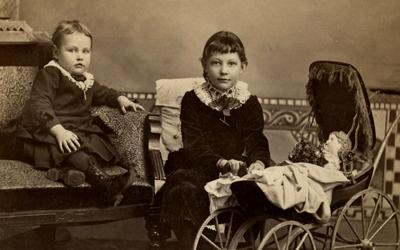
Description
The portrait is of two young girls with doll, covered by a blanket, laying in their baby buggy. The photograph was taken in Shenandoah, Iowa, in 1890. This style of portrait was known as a cabinet card, where photographs are mounted on stiff pieces of cardboard.…
Children Waiting for the Train, June 30, 1893
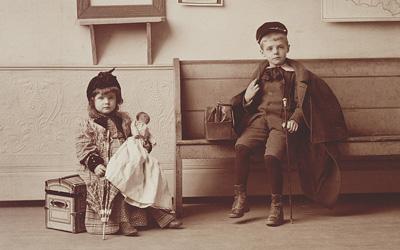
Description
This 1893 photograph shows a boy and girl at a train station. The boy sits on a bench wearing a large cape, holding a walking stick, while the girl sits on a small trunk and holds a doll and parasol.
Children Playing with a Dog and Cart in Tennessee, ca. 1903
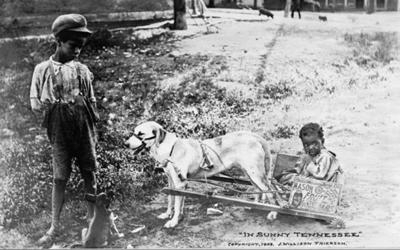
Description
This photograph was taken in 1903 and shows two children playing in Tennessee. One of the children is being pulled in a cart by a dog.
Children in Beijing, China, Play "Blind Man's Bluff," ca. 1924
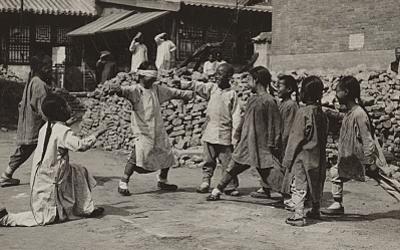
Description
In this photo, taken in Beijing, China, the children are playing "blind man's bluff" which is like the game of tag. In blind man's bluff, the child who is "it" is blindfolded and has to find and tag the other players. Once a player is tagged as it, they have to put on the…
Farmer Earl Pauley's Children Playing with Dolls in Tumbleweed Near Smithland, Iowa, December 1936
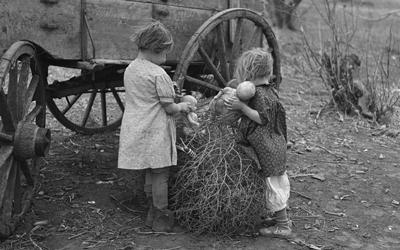
Description
This photograph shows two daughters of tenant farmer Earl Pauley playing with their dolls in tumbleweed near Smithland, Iowa in 1936. The image was taken by photographer Russell Lee, who was hired by the federally-sponsored Farm Security Administration to be part of the…
Children Playing with Boats in Grundy Center, Iowa, April 1940
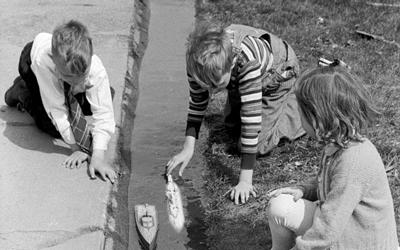
Description
The image shows three children from Grundy Center, Iowa, playing outside with toy boats. The 1940 photograph was taken by John Vachon, an employee of the Farm Security Administration, who was employed to publicize the conditions of the rural poor in America.
Children Play "Ring Around the Rosie" in Chicago, Illinois, April 1941
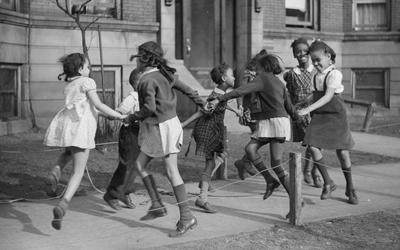
Description
The children in this photo live in Chicago, Illinois. They are playing "ring around the rosie" on the sidewalk. The ring around the rosie game involves children forming a ring and dancing in a circle around a person. When they say the final line everyone stoops or curtsies.…
U.S. Mail Sled Being Pulled by Horses in Alaska, between 1900 and 1927
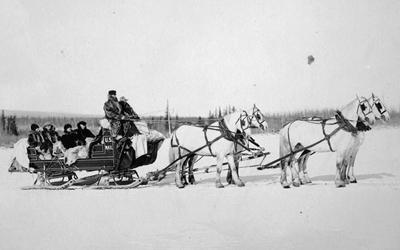
Description
The photo shows a team of horses pulling a U.S. Postal Service mail sled. The image of the postal carriers was taken near Nome, Alaska, between 1900 and 1927.
Yaeko Nakamura and Family Buy Toys from Fred Moriguchi at Manzanar Relocation Center, 1943
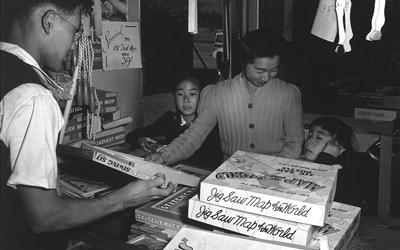
Description
This image, taken by renown American photographer Ansel Adams, shows Yaeko Nakamura looking at puzzles with her daughters, Louise Tami and Joyce Yuki Nakamura in a store within the Manzanar Relocation Center in 1943. They are being assisted by the store clerk, Fred…
Man and Woman at Desk with Typewriter, between 1909 and 1932
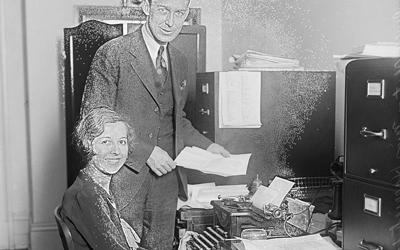
Description
An unidentified man and a woman are shown posing in an office with a typewriter. Before computers, typewriters were used for decades to produce printed text. Typewriters allowed people in homes and offices to use printed text instead of handwriting.
Telephone Operators, between 1914 and 1917

Description
Until the 1960s, telephone companies used manual switchboards to connect calls. Switchboard operators inserted a pair of phone plugs into jacks. In this photograph, which was taken between 1914 and 1917, six female switchboard operators worked to connect people’s calls.…
Lady Signaling Operator on Old-Style Telephone in Scranton, Iowa, April 1940
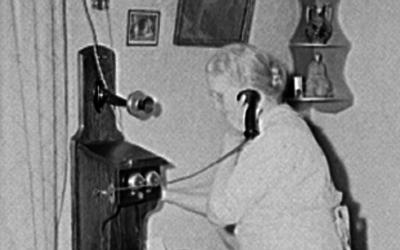
Description
A Scranton, Iowa, resident is photographed calling a switchboard operator to connect her call. The 1940 photograph was taken by John Vachon, an employee of the Farm Security Administration, who was employed to publicize the conditions of the rural poor in…
Crowd of Men Listening to World Series Game in Saint George, Utah, September 1940
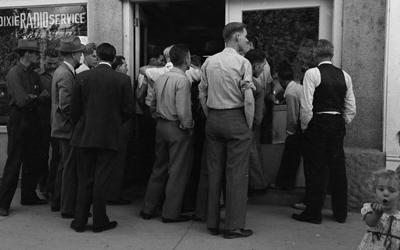
Description
The photograph shows a crowd of men in Saint George, Utah, gathered outside a radio shop that is broadcasting World Series baseball game between the Cincinnati Reds and the Detroit Tigers. Before televisions became widely available, radio broadcasting was a…
Airborne Infantry Officer Using a Walkie-Talkie in Louisiana, 1942

Description
An infantry soldier in Louisiana uses a walkie-talkie to communicate during World War II. Walkie-talkies were invented at this time to allow soldiers to communicate on the battlefield. A walkie-talkie has a speaker built into one end and a microphone in the other to send…
Taking High School Classes via Television in Little Rock, Arkansas, September 1958

Description
This 1958 photograph shows an African-American high school girl being educated via television in her living room. During this period, the schools in her Arkansas community were closed to avoid integration after the Brown vs. Board of Education decision, a…
Ambulance Wagons on the Bull Run Battlefield, 1861
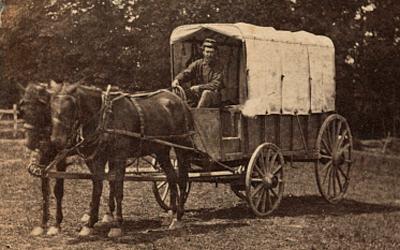
Description
During the American Civil War (1861-1865), ambulance wagons pulled by horses were used to transported sick or wounded soldiers off the battlefield. The photograph shown from 1964 is of a man posed in an ambulance wagon on the battlefield of Bull Run in Virginia. …
Logs Being Hauled on a Sleigh by a Team of Horses, between 1900 and 1930
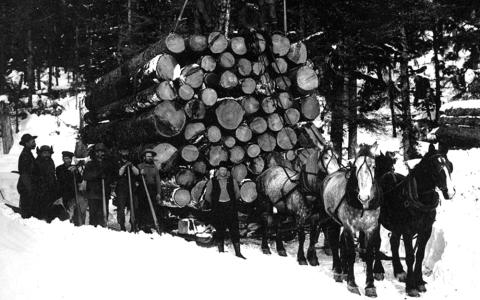
Description
The image shows logs being hauled on a sleigh by a team of horses along the government railway. The photograph, taken between 1900 and 1930, was taken 35 miles from Seward, Alaska.
Horse-Drawn Wagons Removing Snow in New York City, January 1908

Description
This photograph shows a line of horse-drawn wagons hauling snow in New York City. The 1908 image was taken before the widespread use of motorized trucks.
Children in an Automobile, between 1912 and 1930

Description
Two children are shown riding in an early model of the automobile. In 1908, automobiles became more widely available to Americans when the Ford Motor Company began mass producing them on factory assembly lines.
Crowd and Trolley Cars in Washington, D.C., between 1913 and 1917

Description
This image shows a busy intersection in Washington, D.C., our nation’s capital. The trolley cars in the photo were fully electric when the image was taken between 1913 and 1917.
Parked School Buses Near Wells, Texas, April 1939
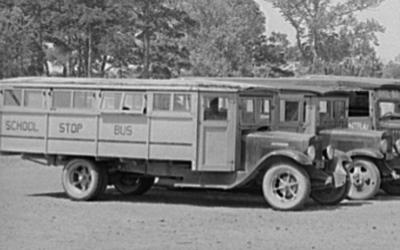
Description
This 1939 photograph features motorized school buses in Wells, Texas, that were used in the early 20th century. Unlike today’s buses, they were made of wood, rather than metal.
Workers Boarding a Trackless Trolley in Baltimore, Maryland, April 1943
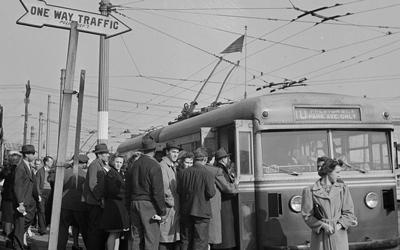
Description
Workers are shown boarding a trolley car in Baltimore, Maryland, in 1943. The trolley cars were fully electric and powered by overhead lines. Trackless trolleys are more economical than buses to run because they require no gas, but do use tires.
Additional Resources:
- The Goldfinch: Iowa Folklife (Vol. 10, No. 4, pgs. 11-12, April 1989)
This Iowa history magazine for children was published quarterly by the State Historical Society of Iowa from 1975-2000. Each issue focuses on a theme and this particular volume highlighted immigration in Iowa and included articles, games, photos and fiction. The featured article in this edition looked at the games played by Iowans at the turn of the 20th century. - Transportation: Then and Now by Robin Nelson
This book presents a brief look at how transportation has changed over the years. - Toys and Games: Then and Now by Robin Nelson
This book briefly describes how toys and games have changed through the years, including such topics as how playgrounds differ and how today's toys relate to those of the past. - Communication: Then and Now by Robin Nelson
This book briefly describes how communication in the United States has changed through the years.
Iowa Core Social Studies Standards (K)
Listed below are the Iowa Core Social Studies content anchor standards that are best reflected in this source set. The content standards applied to this set are elementary-age level and encompass the key disciplines that make up social studies for kindergarten students.
| No. | Standard Description |
| SS.K.7. | Describe ways in which students and others are alike and different within a variety of social categories. |
| SS.K.15. | Explain why and how people move from place to place. |
| SS.K.16. | Distinguish at least two related items or events by sequencing them from the past to the present. |
| SS.K.17. | Compare life in the past to life today. |
| SS.K.18. | Given context clues, develop a reasonable idea about who created the primary source or secondary source, when they created it, where they created it, or why they created it. |